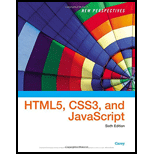
New Perspectives on HTML5, CSS3, and JavaScript
6th Edition
ISBN: 9781305503922
Author: Patrick M. Carey
Publisher: Cengage Learning
expand_more
expand_more
format_list_bulleted
Question
Chapter 1, Problem 12CP3
Program Plan Intro
To copy the content of body header and body footer part from dr_index.html to dr_info.html. Also insert section element between header and footer.
Expert Solution & Answer
Want to see the full answer?
Check out a sample textbook solution
Students have asked these similar questions
Create a relationship between the common field (Technician Number) of the two tables. Make sure that each client must have 1 and only 1 technician assigned, and each technician can have multiple clients.
2. Create a query to show the Client Number, Client Name, Billed, Paid for clients in Anderson city. Save the query.
3. Create a query to show the Technician Number, Last Name, First Name, YTD Earnings for technicians whose Hourly Rate is greater than or equal to 30. Save the query.
4. Create a query to show Client Number, Client Name, Billed, Paid for clients whose technician number is 22 and whose Billed is over 300. Save the query.
5. Create a query to show the Technician Number, Last Name, First Name, Client Number, Client Name for clients whose technician number 23. Save the query.
6. Create a query to show the Technician Number, Last Name, First Name, Client Number, Client Name for clients whose technician number 23 or 29. Save the query Help please Microsoft office access
Dijkstra's Algorithm (part 1). Consider the network shown below, and Dijkstra’s link-state algorithm. Here, we are interested in computing the least cost path from node E (note: the start node here is E) to all other nodes using Dijkstra's algorithm. Using the algorithm statement used in the textbook and its visual representation, complete the "Step 0" row in the table below showing the link state algorithm’s execution by matching the table entries (i), (ii), (iii), and (iv) with their values. Write down your final [correct] answer, as you‘ll need it for the next question.
4. |z + 5 - 5i| = 7
Chapter 1 Solutions
New Perspectives on HTML5, CSS3, and JavaScript
Ch. 1.1 - Prob. 1QCCh. 1.1 - Prob. 2QCCh. 1.1 - Prob. 3QCCh. 1.1 - Prob. 4QCCh. 1.1 - What is incorrect about the following code?...Ch. 1.1 - Prob. 6QCCh. 1.1 - Prob. 7QCCh. 1.1 - Prob. 8QCCh. 1.1 - Prob. 9QCCh. 1.2 - Prob. 1QC
Ch. 1.2 - Prob. 2QCCh. 1.2 - Prob. 3QCCh. 1.2 - Prob. 4QCCh. 1.2 - Prob. 5QCCh. 1.2 - Prob. 6QCCh. 1.2 - Prob. 7QCCh. 1.2 - Prob. 8QCCh. 1.2 - Prob. 9QCCh. 1.3 - Prob. 1QCCh. 1.3 - Prob. 2QCCh. 1.3 - Prob. 3QCCh. 1.3 - Prob. 4QCCh. 1.3 - Prob. 5QCCh. 1.3 - Prob. 6QCCh. 1.3 - Prob. 7QCCh. 1.3 - Prob. 8QCCh. 1.3 - Prob. 9QCCh. 1 - Prob. 1RACh. 1 - Prob. 2RACh. 1 - Prob. 3RACh. 1 - Prob. 4RACh. 1 - Prob. 5RACh. 1 - Prob. 6RACh. 1 - Prob. 7RACh. 1 - Prob. 8RACh. 1 - Prob. 9RACh. 1 - Prob. 10RACh. 1 - Prob. 11RACh. 1 - Prob. 12RACh. 1 - Prob. 13RACh. 1 - Prob. 14RACh. 1 - Prob. 15RACh. 1 - Prob. 16RACh. 1 - Prob. 17RACh. 1 - Prob. 18RACh. 1 - Prob. 19RACh. 1 - Prob. 20RACh. 1 - Prob. 21RACh. 1 - Prob. 22RACh. 1 - Prob. 23RACh. 1 - Prob. 1CP1Ch. 1 - Prob. 2CP1Ch. 1 - Prob. 3CP1Ch. 1 - Prob. 4CP1Ch. 1 - Prob. 5CP1Ch. 1 - Prob. 6CP1Ch. 1 - Prob. 7CP1Ch. 1 - Prob. 8CP1Ch. 1 - Prob. 9CP1Ch. 1 - Prob. 10CP1Ch. 1 - Prob. 11CP1Ch. 1 - Prob. 12CP1Ch. 1 - Prob. 13CP1Ch. 1 - Prob. 14CP1Ch. 1 - Prob. 15CP1Ch. 1 - Prob. 16CP1Ch. 1 - Prob. 1CP2Ch. 1 - Prob. 2CP2Ch. 1 - Prob. 3CP2Ch. 1 - Prob. 4CP2Ch. 1 - Prob. 5CP2Ch. 1 - Prob. 6CP2Ch. 1 - Prob. 7CP2Ch. 1 - Prob. 8CP2Ch. 1 - Prob. 9CP2Ch. 1 - Prob. 10CP2Ch. 1 - Prob. 11CP2Ch. 1 - Prob. 12CP2Ch. 1 - Prob. 1CP3Ch. 1 - Prob. 2CP3Ch. 1 - Prob. 3CP3Ch. 1 - Prob. 4CP3Ch. 1 - Prob. 5CP3Ch. 1 - Prob. 6CP3Ch. 1 - Prob. 7CP3Ch. 1 - Prob. 8CP3Ch. 1 - Prob. 9CP3Ch. 1 - Prob. 10CP3Ch. 1 - Prob. 11CP3Ch. 1 - Prob. 12CP3Ch. 1 - Prob. 13CP3Ch. 1 - Prob. 14CP3Ch. 1 - Prob. 15CP3Ch. 1 - Prob. 16CP3Ch. 1 - Prob. 17CP3Ch. 1 - Prob. 18CP3Ch. 1 - Prob. 19CP3Ch. 1 - Prob. 20CP3Ch. 1 - Prob. 21CP3Ch. 1 - Prob. 22CP3Ch. 1 - Prob. 23CP3Ch. 1 - Prob. 24CP3Ch. 1 - Prob. 25CP3Ch. 1 - Prob. 26CP3Ch. 1 - Prob. 1CP4Ch. 1 - Prob. 2CP4Ch. 1 - Prob. 3CP4Ch. 1 - Prob. 4CP4Ch. 1 - Prob. 5CP4Ch. 1 - Prob. 6CP4Ch. 1 - Prob. 7CP4
Knowledge Booster
Similar questions
arrow_back_ios
SEE MORE QUESTIONS
arrow_forward_ios
Recommended textbooks for you
 New Perspectives on HTML5, CSS3, and JavaScriptComputer ScienceISBN:9781305503922Author:Patrick M. CareyPublisher:Cengage LearningCOMPREHENSIVE MICROSOFT OFFICE 365 EXCEComputer ScienceISBN:9780357392676Author:FREUND, StevenPublisher:CENGAGE L
New Perspectives on HTML5, CSS3, and JavaScriptComputer ScienceISBN:9781305503922Author:Patrick M. CareyPublisher:Cengage LearningCOMPREHENSIVE MICROSOFT OFFICE 365 EXCEComputer ScienceISBN:9780357392676Author:FREUND, StevenPublisher:CENGAGE L

New Perspectives on HTML5, CSS3, and JavaScript
Computer Science
ISBN:9781305503922
Author:Patrick M. Carey
Publisher:Cengage Learning

COMPREHENSIVE MICROSOFT OFFICE 365 EXCE
Computer Science
ISBN:9780357392676
Author:FREUND, Steven
Publisher:CENGAGE L